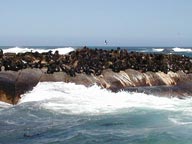


 |
 |
 |
|
|
Cape Town from Table Mountain
|
The Water Front
|
The seals of Seal Island
|
The pinguins of Boulders
|
 |
|
The South African Republic is situated in the
southmost end of Africa, and is between two oceans: the Indian Ocean in
the east, influenced by the warm current from Mozambique, and Atlantic
Ocean in the west, with the cold Benguela current, coming from South Pole.
The surface of S.A. is 1.223.226 sq.Km., which corresponds to the sum
of Italy, France, Germany, Holland and Belgium (almost 4,5 times Italy).
S.A. is split up into 9 different provinces: Gauteng, North-West, Northern
Province, Mpumalanga, KwaZulu-Natal, Free State, Western Cape e Northern
Cape. Very little countries in the world can compete with S.A. for
the beauty and the veriety of the landscapes, and also for the facilities
of a high international standard and for the many other surprises of the
demanding tourist. |
Cape Town
|
Known with the name of "Pearl of Africa",
Cape Town is certainly one of the most fascinating and attracting towns
of all the african continent. Founded in 1652 by the dutch Jan Van Riebeck,
Cape Town was for many years an important supplying base for the Dutch
Company of Indes, serving as landing place for its ships sailing to the
East. Nowadays, Cape Town is a cosmopolitan town with over 3 millions
inhabitants, facing the Atlantic Ocean, dominated by the impressive landscape
of the Table Mountain, symbol of Cape Town. The mountain is 1087
meters high and it owes the name to the plate top. It is not rare, on
the contrary, to see the top covered by a thick blanket of clouds that
flow down to the sides. This is the result of cold atlantic currents collision
with the more humid ones of the Indian Ocean. In the nearby is located
the romantic region of the vineyards of the Cape. Therefore, mountain
and hill in a single town; not by chance Cape Town is known as "mother
town".
Nestled in a sheltered cove between Simon's
Town and Cape Point, Boulders has become world famous for its thriving
colony of African Penguins and magnificent wind sheltered, safe beaches.
Although set in the midst of a residential area, it is one of the few
sites where this vulnerable bird (Spheniscus demersus) can be observed
at close range, wandering freely in a protected natural environment. |